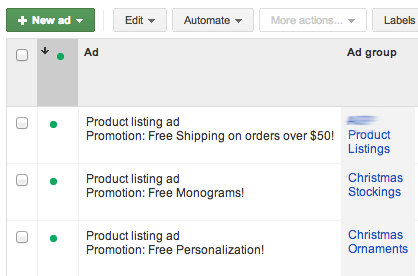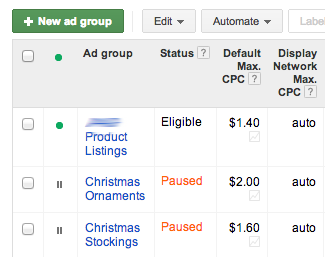- By: Sydney Hadden
- January 18, 2013
Adwords Product Listings: Tips on Maximizing Google Shopping ROI
As I mentioned in my recent blog post Google Shopping: Merchant Center Step-by-Step Setup Guide, setting up a product listings campaign can be tedious, especially with the limited help available from Google. After writing that blog it occurred to me that after people got their Merchant Center setup, they might also benefit from learning the top ways to optimize the product listing campaigns. After all, who doesn’t want more money (apart from the baby from Capital One)? While product listings tend to be the most hands off, self-promoting method of campaigns in AdWords, it still requires some ongoing monitoring and optimization, especially to get started.
1. Campaign Set Up
Organizing your campaign into relevant and separate ad groups will help you to optimize your campaign. Separate by product type or category to help organize and test which groupings perform best in this advertising format. It will also help you build targeted keyword and ad promotion strategies to coincide with your groups and campaigns. For example if you group sales products together you can target keywords to include terms such as “sale” “discount” or “deal”. Similarly, if you choose to separate by product function you may be able to target things such appropriate to each of their uses. Breaking down into granular groups will also increase control on both spend and ROI.
2. Negative Keywords
Including a list of negative keyword will exponentially improve the cost effectiveness of your campaign. Negative keywords ensure that when consumer’s search the terms on the negative list, your ads will not be served. By including terms irrelevant to specifically purchasing your products/services, you effectively target your desired market. Ideally, terms from the research phase of the buying process such as “ideas” or “what is” should be excluded. Similarly, terms associated with specific locations or zip codes can be excluded. This is particularly beneficial for local businesses or if your company only distributes to certain parts of the country. Another key strategy is to focus your AdWords budget on those products that you know have a high return on investment. Excluding terms such as “cheap shoes” or the names of your products with low margins will help focus your budget to generate the most profit (you can also exclude products from triggering ads through product filters). The negative keyword list will completely depend on your company, products, goals, and target market. This is definitely the most time-consuming aspect of optimizing a campaign, but will probably produce the most dramatic results.
3. Ad Promotion
Similar to regular ads within AdWords, you can create several ads with different copy to run with your products. The best way to optimize this function is to use copy that will entice your consumer to click. Offering extra value such as “Free Shipping!” or “Buy One Get One Free” will help motivate the consumer, and increase conversions. Try testing a few versions to see which converts at the best value for your products. If you’ve built out an extensive campaign with many ad groups, it’s important to create several ads that will cater to the specific groupings you’ve developed. The more targeted and specific you are, the greater your chances are of generating qualified leads.
PPC campaigns are like babies (maybe not quite like the one mentioned before), they need a little bit of love and attention, care, and food (money) to grow. Similarly, time is ultimately the test of your success. Make sure you monitor your campaigns daily, continue to optimize and test new strategies in order to get the greatest return on your investment. As Google continues to progress with its paid Shopping tactic, optimization will be key.



